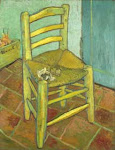
On this Easter weekend, as Christians the world over ponder the mystery of Christ's death and resurrection, it seems appropriate to post perhaps the most famous image of the Lamentation in the history of art: Giotto di Bondone's Lamentation from the Arena Chapel (Cappella Scrovegni) in Padua, Italy, dating to the beginning of the fourteenth century. This image (click to enlarge) comes in a series of panels presenting the life of Christ, and this particular panel is the one that appears in all the art history survey books. I teach it every year, and every year we discuss the emotion Giotto created in the scene, the way he draws the viewer into the story. John the Evangelist flings back his arms in despair, Mary Magdalene cradles Jesus' feet, his mother cradles his head. It is a moving and powerful image.
I first studied the scenes of the Arena Chapel nearly twenty years ago in an undergraduate Italian Renaissance Art class at Emory University. My professor was Dr. John Howett, a kindly, gentle man who in his calm and quiet way unveiled the stories behind Renaissance art and inspired many a student during his 35 years of teaching, myself included. We spent two lectures on the Arena Chapel, as I recall, and in discussing the Lamentation, he told us something that to a college sophomore was rather shocking: that our textbook author was *wrong.* (Whether he put it that bluntly I honestly don't remember, but in my class notes, which I still have, it says "Hartt is wrong.") The textbook said that the tree standing in the background was dead, thus reflecting the death of Christ. That's not right, Dr. Howett told us: if you look closely, at the top of the tree especially, there are small green buds. The tree only looks dead. It is waiting for spring, and it will become green again, just as Christ will be resurrected. Giotto has put a note of hope in the otherwise sad scene. I have not forgotten Dr. Howett's lecture, and every year when I teach my survey students, I tell them that their textbook -- a different one, but one which still says the tree is dead -- is wrong. "My professor at Emory, Dr. Howett, always said..." I tell them, and I show them a blown-up image of the tree so they can make out the buds. The students nod their heads, and if I'm lucky, some of them remember and mention it on the test. If I'm really lucky, they'll remember it twenty years from now.
I learned last night that Dr. Howett passed away a few days ago, unexpectedly at the age of 82. My heart is heavy today, as I'm sure everyone who knew and loved him must feel sad too. He was the soul and spirit of the Emory art history department -- quite literally, since he was one of its founders. He retired while I was in graduate school there, but he came to the department for lectures and receptions, to the library to do research, and sometimes he'd stop by just to say hello, always with a friendly word and smile. He won several teaching awards during his career, and he was about to be awarded the 2009 Woolford Baker Award for lifetime achievement in the arts from Emory's Michael C. Carlos Museum, another place where his longtime influence is still felt. He will be missed by all whose lives he touched. But his ideas will live on.






3 comments:
What a wonderful story!
Thank you!
a wonderful story, but one with a bittersweet ending. The passing of senior scholars is always a moment for reflection.
Post a Comment